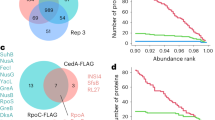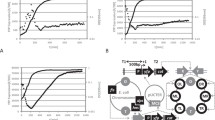Summary
The ccd operon of plasmid F produces three proteins, CcdA, CcdB, and RepD. Prior research has established that the operon is autorepressed and that at least CcdB, but not RepD, is required for autorepression. A role for CcdA in autorepression was suggested but not clearly shown. We now present a series of biochemical experiments which show that both CcdA and CcdB proteins are required for maximal formation of protein-ccd operator complexes. We also show that CcdA and CcdB are present in a complex whether or not ccd operator is present. The clear implication is that autorepressor is a complex of CcdA and CcdB. We also map the start site of the ccd transcript thus providing the first experimental evidence for the location of the ccd promoter.
Similar content being viewed by others
References
Bailone A, Brandenburger A, Lévine A, Pierre M, Dutreix M, Devoret R (1984) Indirect SOS induction is promoted by ultraviolet light-damaged miniF and requires the miniF lynA locus. J Mol Biol 179:367–390
Bailone A, Sommer S, Devoret R (1985) Mini-F plasmid-induced SOS signal in Escherichia coli is RecBC dependent. Proc Natl Acad Sci USA 82:5973–5977
Bex F, Karoui H, Rokeach L, Dréze P, Garcia L, Couturier M (1983) Mini-F encoded proteins: Identification of a new 10.5 kilodalton species. EMBO J 2:1853–1861
Caughey PA, de Feyter R, Lane HED (1986) The miniF plasmid C protein: Sequence, purification and DNA binding. Nucleic Acids Res 14:9699–9712
Feyter R de, Wallace C, Lane D (1989) Autoregulation of the ccd operon in the F plasmid. Mol Gen Genet 218:481–486
Fried M, Crothers DM (1981) Equilibria and kinetics of lac repressor-operator interactions by polyacrylamide gel electrophoresis. Nucleic Acids Res 9:6505–6525
Hager DS, Burgess RR (1980) Elution of proteins from sodium dodecyl sulfate-polyacrylamide gels, removal of sodium dodecyl sulfate, and renaturation of enzymatic activity: Results with sigma subunit of Escherichia coli RNA polymerase, wheat germ DNA topoisomerase, and other enzymes. Anal Biochem 109:76–86
Hazen GG (1974) Method for automatic analyzers. Methoden der Enzymatsch Analyze 1:1000–1005
Hiraga S, Jaffé A, Ogura T, Mori H, Takahashi H (1986) F plasmid ccd mechanism in Escherichia coli. J Bacteriol 166:100–104
Jaffé A, Ogura T, Hiraga S (1985) Effects of the ccd function of the F plasmid on bacterial growth. J Bacteriol 163:841–849
Karoui H, Bex F, Dréze P, Couturier M (1983) Ham22, a mini-F mutation which is lethal to host cell and promotes recA-dependent induction of lambdoid prophage. EMBO J 2:1863–1868
Laemmli UK (1970) Cleavage of structural proteins during the assembly of the head of bacteriophage T4. Nature 227:680–685
Lane D, Hill D, Caughey P, Gunn P (1984) The mini-F primary origin: Sequence analysis and multiple activities. J Mol Biol 180:267–282
Linn T, Ralling G (1985) A versatile multiple- and single-copy vector system for the in vitro construction of transcriptional fusion to lacZ. Plasmid 14:134–142
MacDonald RJ, Swift GH, Przybyla AE, Chirgwin UM (1987) Isolation of RNA using guanidinium salt. Methods Enzymol 152:219–227
Miki T, Chang Z-T, Horiuchi T (1984a) Control of cell division by sex factor F in Escherichia coli. II. Identification of genes for inhibitor protein and trigger protein on the 42.84–43.6 F segment. J Mol Biol 174:627–646
Miki T, Yashioka K, Horiuchi T (1984b) Control of cell division by sex factor F in Escherichia coli. I. The 42.84–43.6 F segment couples cell division of the host bacteria with replication of plasmid DNA. J Mol Biol 174:605–625
Studier FW, Moffatt BA (1986) Use of bacteriophage T7 RNA polymerase to direct selective high-level expression of cloned genes. J Mol Biol 189:113–130
Tam JE, Kline BC (1989) Control of the ccd operon in plasmid F. J Bacteriol 171:2353–2360
Yanisch-Perron C, Vieira J, Messing J (1985) Improved M13 phage cloning vectors and host strains: Nucleotide sequences of the M13mp18 and pUC19 vectors. Gene 33:103–119
Author information
Authors and Affiliations
Additional information
Communicated by R. Deveoret
Rights and permissions
About this article
Cite this article
Tam, J.E., Kline, B.C. The F plasmid ccd autorepressor is a complex of CcdA and CcdB proteins. Molec. Gen. Genet. 219, 26–32 (1989). https://doi.org/10.1007/BF00261153
Received:
Issue Date:
DOI: https://doi.org/10.1007/BF00261153




